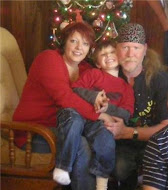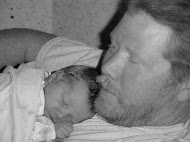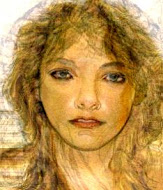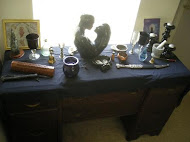The link I had for the base of this now defunct, sorry. If you wrote part of this, and you aren’t credited, and you have a page, please let me know & I’ll put it up :) Anything I have the source for is linked.
The annals of ghost lore contain a number of stories about burial markers that may possibly be more frightening than the tales of the cemeteries where these stones reside! Grave markers and simple tombstones can play host to a surprising number of stories and legends. There are stones across America that people claim to have been not only cursed, but literally move on their own! Is the supernatural at work, or the darker devices of man’s own imagination? Gravestones and markers have a myriad of meanings and symbolize both comfort and grief... but are they all what they appear to be?
From Beyond The Grave
Acorn – Symbolic of a baby or young child.
Alpha and Omega – This symbol represents the beginning & the end.
Apple – Apples can represent salvation. Contradictorily they can also represent sin…
Angels - Agents of God guarding the dead. Also, angels were seen as the emissaries between this world and the next. In some cases they appeared as mourners and in others as an offer of comfort for those who are left behind
Archway: Because death is thought of as the gateway to heaven the use of an archway symbolizes the passage through which the soul will travel. Sometime it is simply the stone itself that is carved like an arch or it may be carved into the stone itself. Sometimes the stone may be adorned with pillars, draperies or other such devices used to indicate an archway
Arrows or Darts: Arrows or darts were often used in gravestone carvings and it has been suggested that these represented the "dart of death," referring to the threat of attack by Indians. Also symbolic of death or mortality, (and not that the interred lingered at pubs).
Beehive – Beehives are frequently used by Freemasons, and are said to stand for faith, education & domestic virtue.
Bell - A bell is often symbolic of the church bell and therefore symbolizes religion.
Bible or Opened Book - A bible opened to a page of scripture or an opened book was used to represent the word through which one gains revelation. Often used on the gravestones of ministers or clergymen. Books may also represent a person's good deeds and accomplishments being recorded in the book of life.
Broken Column: A broken column indicates the loss of the Head of the Family.
Broken Ring – A broken ring indicates a family circle severed.Bugles – A bugle (or bugles) is symbolic of resurrection or of the military.
Butterfly – Based on its evolution from egg to caterpillar to chrysalis to butterfly, it represents the soul, transformation and rebirth, the creation of life from apparent death. To the Chinese, the butterfly symbolizes immortality. The Japanese view it as a symbol of fickleness because of its flighty behavior, although a pair of butterflies represents marital
happiness and a white butterfly signifies the spirit of the dead. In Christianity, the butterfly can be a symbol of resurrection but is sometimes viewed also as symbolic of transience because of its short lifespan. Alternately it can be symbolic of vanity.
Candle – In Christianity, candles represent the divine light of Christ and faith. In Catholic funeral rites, candles signify the light of heaven. When lighted by worshippers and placed before shrines, candles signify the souls of the departed or a request for illumination by prayer. When on opposite sides of a cross on an altar, the two candles represent the dual nature of Christ, human and divine. Many religions and cultures use the burning candle as a symbol of light, life, spirituality, truth and eternal life. A candle snuffed represents time & mortality.
Celtic Cross – In pagan times, this cross, with its axis enclosed by a circle, was a symbol of fertility and life, the cross representing male potency and the circle, female power. Prevalent in Ireland, it is now primarily a Christian symbol signifying the unity of heaven and earth. Can also be symbolic of someone of Irish ancestry.
Chalice - Honoring the sacraments.
Circle – Eternity
Clasped Hands – Farewell to earthly existence. Also unity. On a sidenote, in the Native American culture clasped hands represent a Delaware grave.
Clock / Watch - Represents the transitory nature of human existence. In psychoanalysis it signifies human emotions, not that your hour is up. It also can represent new beginnings and opportunities.
Coat of Arms - High social status and family lineage.
Cocks and Peacocks - Because Saint Peter was awakened from his fall from grace by the crowing of the cock (Bible Luke 22:34) the cock or peacock was used to symbolize both the fall from grace and repentance.
Coffins and Urns - Coffins and urns are used to symbolize the death of the flesh and are usually used in conjunction with a body or soul effigy. Coffins were also often carved on 17th and 18th century New England gravestones to signify mortality.
Corn - Ripe Old Age.
Cornucopia - Also known as the "Horn of Plenty." Symbolizes an abundant, fruitful life. Also a symbol of the harvest, which in turn symbolizes the end of life.
Cribs & Beds – Usually found marking the graves of children, they are most often empty, symbolizing that these little ones are gone forever.
Crossed Swords - High-ranking military person. When inverted they signify death in battle.
Crowns – Crowns represent the crown of righteousness used to proclaim the victorious soul arisen to heaven through Christ. Commonly used on 18th century New England headstones. They also represent heavenly reward, and indicate a faithful Christian.
Cypress Tree - Deep mourning
Dog - Loyalty, Vigilance, Courage. As a symbol of faithfulness, dogs often appear at the feet of women on medieval tomb engravings. In Christianity, the dog guards and guides the flock, and so becomes an allegory of the priest. The dog is also a companion of the dead on their crossing. Ancient Egyptians and Greeks believed it followed its master into the afterlife. Many cultures believed that dogs were mediators with the realm of the dead: the Egyptian god Anubis who oversees embalming and weighs the heart of the dead is jackal-headed, Cerburus the guardian of the entrance to the Greek underworld is a three-headed dog with a serpent's tail, the dog Garmr guards the Norse underworld. The Celts and Greeks believed dogs possessed healing powers. In some African cultures, the dog is the father of civilization and the bringer of fire. In the eleventh sign of the Chinese zodiac, the dog symbolizes idealism. In Chinese tradition, the dog can signify both catastrophe and protection. Among Jews and Moslems, the dog possesses negative attributes. It is unclean and, when black, signifies the Devil.
The Dove or the Bird - The dove or the bird is used as the symbol of Christian constancy or devotion. A dove as the only figure indicating a deeply devoted Christian. Also symbolic of the Holy Spirit or peace.
Eagle - The eagle is a symbol of courage, also indicative of military service. Eagles are often seen on gravestones of Civil War veterans.
Fern – The fern represents grief, humility and sincerity.
Flames Arising from the Top of an Urn - The flame represents the soul arising out of the ashes of death.
Flowers - Since the time of Christ, flowers have represented the life of Man, symbolizing the brevity and the beauty of his life. A cut flower hanging upside-down symbolizes life being cut down in death. Sometime it is seen with a scythe cutting down the flower but it is usually seen broken in half. Buds are symbolic of the morning of life or renewal of life.
Gourds - The gourd was poplar in the seventeenth and eighteenth century and was used to symbolize the coming to be and the passing away of earthly life. Sometimes gourds were used under soul effigies in fruit columns and are nearly indistinguishable from women's breasts.
Grapevines or Vines - Churches are said to be the vineyards and the congregations are said to be the vines. The grapevine is the emblem of Christ.Sometime we see soul effigies sucking the ends of grapevines, partaking of wine was a major Puritan symbol representing the covenant between God and man through the death of Christ. A bird sitting on a vine eating grapes may mean the soul is partaking celestial food.
Harp – A harp is an indication of praise given to God.
The Heart - The heart is the symbol of the soul in heavenly bliss, the heart is always used in opposition to some symbol of death such as the urn.
The Heart in the Mouth of a Death's-Head - This symbolizes the triumphant soul emerging from death.
Heavenly Bodies - the Sun, the Moon, Stars and Sun - They may simply represent heavenly bodies or be used to symbolize the rising of the soul to heaven. They can also signify that heaven is the abode of the stars and the planets. The half sun symbolizes the setting or end of earthly life and the rising or beginning of heavenly life.
Hourglass - Sometimes the hourglass is seen with wings and represents the swift passage of time.
I.H.S. - Jesus Hominom Saluator - Jesus Saviour of Men
The Imps of Death - The imps are used to represent the triumph of death. They are sometimes armed with arrows of death or are lowering the coffin into the grave.
Lamb – The lamb is a symbol of innocence.
Laurel – The laurel has long been a symbol of victory and/or peace.
Lily- This flower symbolizes chastity, purity, or innocence.
Lion – A lion is seen to be eternally watching over the grave; it also could represent the courage of the diseased or signify resurrection.
Menorah: Symbolic of a person who practiced Judaism
Obelisk – An obelisk is symbolic of eternal life.
Palm – Palms indicate the triumph of a martyr over death
Phoenix – The phoenix found in this setting has the same meaning as when found elsewhere – resurrection.
Pointing Hands – Pointing hands are said to be showing the path to heaven.
Portraits - Sometimes it's a facial portrait and sometimes its a portrait borne upward with wings. These may be considered a form of the soul effigy in some cases or the deceased persons station in life.
Praying Hands – Indicates praying for eternal life
Rose – A rose is indicative that the person was sinless.
Scallop Shell - This is considered the traditional symbol of the pilgrim's crusade and of man’s earthly pilgrimage.
Scythe - This symbol is usually seen in the hands of father time and is used to represent the cutting short of a mans life.
Shepherd’s Crooks – Shepherd’s crooks, usually found on graves of Independent Order of Odd Fellows members (a fraternal organization). Symbolizes the opening of earth to the heavens.
Snake – The snake has always had positive pagan associations, and in this setting symbolizes eternity.
Star of David – A Star if David is symbolic of a person practicing Judaism.
Station-in Life Symbol - These symbols would be used to represent the rank or occupation of the deceased. They could be the family coats of arms, military insignia, ships, tools, musical instruments or in the case of preachers – collars.
Sun – The Sun symbolizes a renewed life.
Sundial – A sundial shows the passage of time.
Symbols of the Cause of Death - These stone have carvings actually showing how the person died.
Sword: Sheathed – Symbolic of temperance during conflict.
Sword: Inverted – This is seen to represent victory.
Tree – A tree symbolizes knowledge. A tree also stood for human life and the fact that man, like a tree, must reach for the heavens.
Tree of Life - The tree of life was popular during the 1700's and was used in poetic imagery or used to symbolize earthly or heavenly spiritual life.
Triangle – The triangle was used to represent the Holy Trinity.
Trumpeting Figures - These figures are often found carrying a banner with the words "arise ye dead."
Urns and Mermaids - Mermaids were thought of as symbolizing a dual nature. This may possibly be used to symbolize the duality of Christ as Man and the son of God. They are sometimes seen carrying urns of the deceased's remains which symbolizes the last step of our earthly journey.
Wine, the Divine Fluid - Sacramental tankards and chalices were used to represent the souls partaking of heavenly bliss and are usually only found on stones of deacons of the church.
Sources:
Grave Addiction
Make My Family Tree
At Home With Irish Tinker
Disclaimer: No one involved in this blog or its contents may be held responsible for any adverse reactions arising from following any of the instructions / recipes on this list. It is the reader's personal responsibility to exercise all precautions and use his or her own discretion if following any instructions or advice from this blog















1 comment:
hello... hapi blogging... have a nice day! just visiting here....
Post a Comment